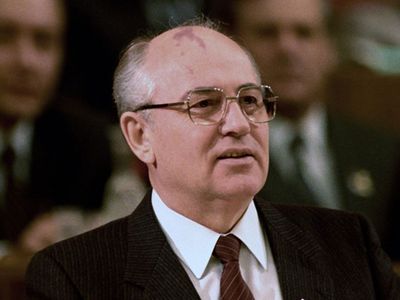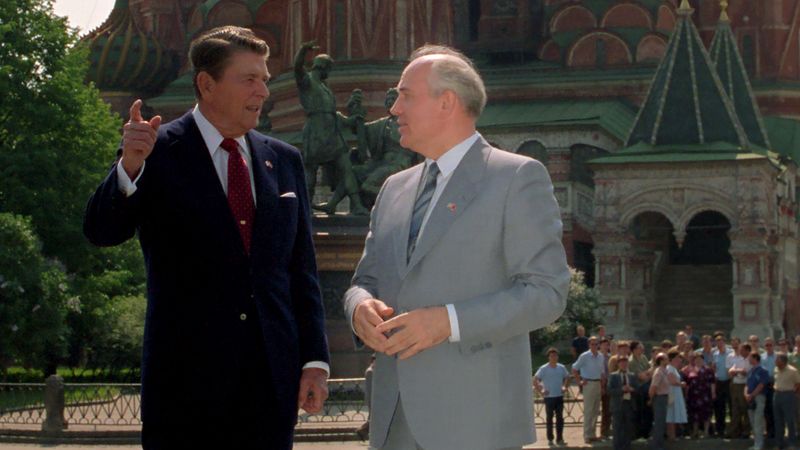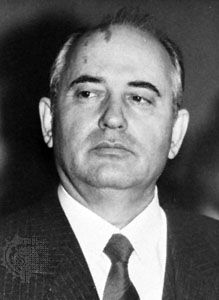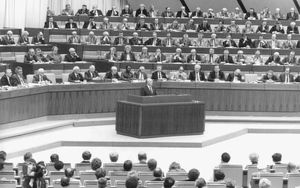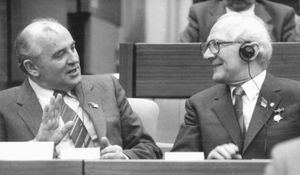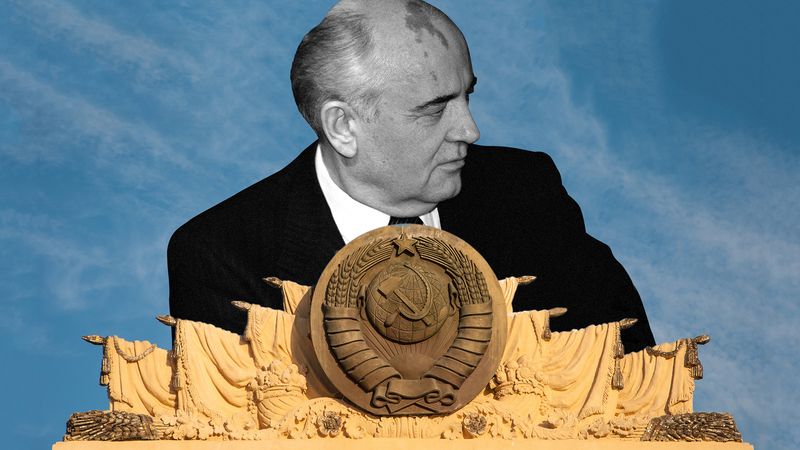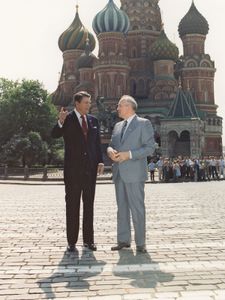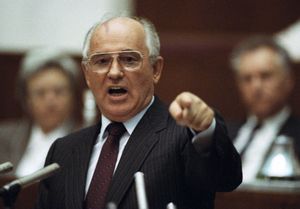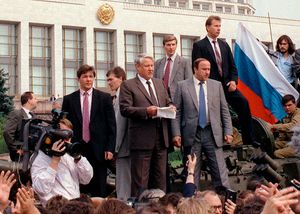-
 Barack Obamapresident of United States
Barack Obamapresident of United States -
 Maksim LitvinovSoviet diplomat
Maksim LitvinovSoviet diplomat -
 Grigory Konstantinovich OrdzhonikidzeSoviet government official
Grigory Konstantinovich OrdzhonikidzeSoviet government official -
Lazar Moiseyevich KaganovichSoviet official
Mikhail Gorbachev
Our editors will review what you’ve submitted and determine whether to revise the article.
- Spartacus Educational - Biography of Mikhail Gorbachev
- Academy of Achievement - Biography of Mikhail S. Gorbachev
- The Nobel Prize - Mikhail Gorbachev
- Age of the Sage - Transmitting the Wisdoms of the Ages - Biography of Mikhail Gorbachev
- RT Russiapedia - Biography of Mikhail Gorbachev
- GlobalSecurity.org - Mikhail S. Gorbachev
- Born:
- March 2, 1931 Russia
- Title / Office:
- president (1990-1991), Soviet Union
- Founder:
- Congress of People’s Deputies
- Political Affiliation:
- Communist Party of the Soviet Union
Who was Mikhail Gorbachev?
How did Mikhail Gorbachev become president of the Soviet Union?
What is Mikhail Gorbachev known for?
What did Mikhail Gorbachev do after the fall of the Soviet Union?
Read a brief summary of this topic
Mikhail Gorbachev, in full Mikhail Sergeyevich Gorbachev, (born March 2, 1931, Privolnoye, Stavropol kray, Russia, U.S.S.R.—died August 30, 2022, Moscow, Russia), Soviet official, general secretary of the Communist Party of the Soviet Union (CPSU) from 1985 to 1991 and president of the Soviet Union in 1990–91. His efforts to democratize his country’s political system and decentralize its economy led to the downfall of communism and the breakup of the Soviet Union in 1991. In part because he ended the Soviet Union’s postwar domination of eastern Europe, Gorbachev was awarded the Nobel Prize for Peace in 1990.
Early life
Gorbachev was the son of Russian peasants in Stavropol territory (kray) in southwestern Russia. He joined the Komsomol (Young Communist League) in 1946 and drove a combine harvester at a state farm in Stavropol for the next four years. He proved a promising Komsomol member, and in 1952 he entered the law school of Moscow State University and became a member of the Communist Party. He graduated with a degree in law in 1955 and went on to hold a number of posts in the Komsomol and regular party organizations in Stavropol, rising to become first secretary of the regional party committee in 1970.
General secretary of the CPSU: perestroika to the fall of the Soviet Union
Gorbachev was named a member of the Central Committee of the Communist Party of the Soviet Union in 1971, and he was appointed a party secretary of agriculture in 1978. He became a candidate member of the Politburo in 1979 and a full member in 1980. He owed a great deal of his steady rise in the party to the patronage of Mikhail Suslov, the leading party ideologue. Over the course of Yury Andropov’s 15-month tenure (1982–84) as general secretary of the Communist Party, Gorbachev became one of the Politburo’s most highly active and visible members; and, after Andropov died and Konstantin Chernenko became general secretary in February 1984, Gorbachev became a likely successor to the latter. Chernenko died on March 10, 1985, and the following day the Politburo elected Gorbachev general secretary of the CPSU. Upon his accession, he was still the youngest member of the Politburo.
Gorbachev quickly set about consolidating his personal power in the Soviet leadership. His primary domestic goal was to resuscitate the stagnant Soviet economy after its years of drift and low growth during Leonid Brezhnev’s tenure in power (1964–82). To this end, he called for rapid technological modernization and increased worker productivity, and he tried to make the cumbersome Soviet bureaucracy more efficient and responsive.
When these superficial changes failed to yield tangible results, Gorbachev in 1987–88 proceeded to initiate deeper reforms of the Soviet economic and political system. Under his new policy of glasnost (“openness”), a major cultural thaw took place: freedoms of expression and of information were significantly expanded; the press and broadcasting were allowed unprecedented candour in their reportage and criticism; and the country’s legacy of Stalinist totalitarian rule was eventually completely repudiated by the government. Under Gorbachev’s policy of perestroika (“restructuring”), the first modest attempts to democratize the Soviet political system were undertaken; multicandidate contests and the secret ballot were introduced in some elections to party and government posts. Under perestroika, some limited free-market mechanisms also began to be introduced into the Soviet economy, but even these modest economic reforms encountered serious resistance from party and government bureaucrats who were unwilling to relinquish their control over the nation’s economic life.
In foreign affairs, Gorbachev from the beginning cultivated warmer relations and trade with the developed nations of both West and East. In December 1987 he signed an agreement with U.S. Pres. Ronald Reagan for their two countries to destroy all existing stocks of intermediate-range nuclear-tipped missiles. In 1988–89 he oversaw the withdrawal of Soviet troops from Afghanistan after their nine-year occupation of that country.
In October 1988 Gorbachev was able to consolidate his power by his election to the chairmanship of the presidium of the Supreme Soviet (the national legislature). But, in part because his economic reforms were being obstructed by the Communist Party, Gorbachev tried to restructure the government’s legislative and executive branches in order to release them from the grip of the CPSU. Accordingly, under changes made to the constitution in December 1988, a new bicameral parliament called the U.S.S.R. Congress of People’s Deputies was created, with some of its members directly elected by the people in contested (i.e., multicandidate) elections. In 1989 the newly elected Congress of People’s Deputies elected from its ranks a new U.S.S.R. Supreme Soviet that, in contrast to its predecessor of that name, was a real standing parliament with substantial legislative powers. In May 1989 Gorbachev was elected chairman of this Supreme Soviet and thereby retained the national presidency.
Gorbachev was the single most important initiator of a series of events in late 1989 and 1990 that transformed the political fabric of Europe and marked the beginning of the end of the Cold War. Throughout 1989 he had seized every opportunity to voice his support for reformist communists in the Soviet-bloc countries of eastern Europe, and, when communist regimes in those countries collapsed like dominoes late that year, Gorbachev tacitly acquiesced in their fall. As democratically elected, noncommunist governments came to power in East Germany, Poland, Hungary, and Czechoslovakia in late 1989–90, Gorbachev agreed to the phased withdrawal of Soviet troops from those countries. By the summer of 1990 he had agreed to the reunification of East with West Germany and even assented to the prospect of that reunified nation’s becoming a member of the Soviet Union’s longtime enemy, the North Atlantic Treaty Organization. In 1990 Gorbachev received the Nobel Prize for Peace for his striking achievements in international relations.
The new freedoms arising from Gorbachev’s democratization and decentralization of his nation’s political system led to civil unrest in several of the constituent republics (e.g., Azerbaijan, Georgia, and Uzbekistan) and to outright attempts to achieve independence in others (e.g., Lithuania). In response, Gorbachev used military force to suppress bloody interethnic strife in several of the Central Asian republics in 1989–90, while constitutional mechanisms were devised that could provide for the lawful secession of a republic from the U.S.S.R.
With the CPSU waning in power and steadily losing prestige in the face of the mounting impetus for democratic political procedures, Gorbachev in 1990 further accelerated the transfer of power from the party to elected governmental institutions. In March of that year the Congress of People’s Deputies elected him to the newly created post of president of the U.S.S.R., with extensive executive powers. At the same time, the Congress, under his leadership, abolished the Communist Party’s constitutionally guaranteed monopoly of political power in the Soviet Union, thus paving the way for the legalization of other political parties.
Gorbachev was conspicuously successful in dismantling the totalitarian aspects of the Soviet state and in moving his country along the path toward true representative democracy. He proved less willing to release the Soviet economy from the grip of centralized state direction, however. Gorbachev eschewed the totalitarian use of power that had traditionally worked to keep the Soviet economy functioning, but at the same time he resisted any decisive shift to private ownership and the use of free-market mechanisms. Gorbachev sought a compromise between these two diametrically opposed alternatives in vain, and so the centrally planned economy continued to crumble with no private enterprise to replace it. Gorbachev remained the undisputed master of the ailing Communist Party, but his attempts to augment his presidential powers through decrees and administrative reshufflings proved fruitless, and his government’s authority and effectiveness began a serious decline. In the face of a collapsing economy, rising public frustration, and the continued shift of power to the constituent republics, Gorbachev wavered in direction, allying himself with party conservatives and the security organs in late 1990.
But the Communist hard-liners who had replaced reformers in the government proved undependable allies, and Gorbachev and his family were briefly held under house arrest from August 19 to 21, 1991, during a short-lived coup by the hard-liners. After the coup foundered in the face of staunch resistance by Russian Pres. Boris Yeltsin and other reformers who had risen to power under the democratic reforms, Gorbachev resumed his duties as Soviet president, but his position had by now been irretrievably weakened. Entering into an unavoidable alliance with Yeltsin, Gorbachev quit the Communist Party, disbanded its Central Committee, and supported measures to strip the party of its control over the KGB and the armed forces. Gorbachev also moved quickly to shift fundamental political powers to the Soviet Union’s constituent republics. Events outpaced him, however, and the Russian government under Yeltsin readily assumed the functions of the collapsing Soviet government as the various republics agreed to form a new commonwealth under Yeltsin’s leadership. On December 25, 1991, Gorbachev resigned the presidency of the Soviet Union, which ceased to exist that same day.


